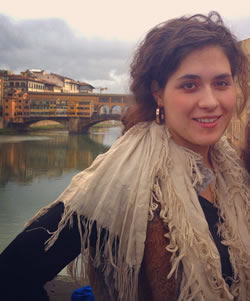“Florence is a city of memories,” my friend Tim remarked during our morning hike. As we stood overlooking the city of Florence, on the same hill where legend claims Leonardo da Vinci launched the first airplane, I couldn’t help but agree that nostalgia permeates the Tuscan city. Here, everything has a story and everything has a connection, intricately fused within the spider web of history, just like the ground on which we were standing.
Since arriving in Florence, I’ve spent my free time wandering in and out of clothing shops. As a budding fashion historian, I get to know a culture through the clothes it sells. While Florence has lost its title as the Italian fashion capital to Milan years ago, it’s still a fashion destination with museums such as the Gucci Museo and the Salvatore Ferragamo museum. However, like the monuments, buildings, and art works that glorify antiquity and early modern history, Florence’s clothing and accessory shops honor the past.
It seems like every day I find a new vintage shop, whether I’m in the main piazza near the Duomo or on the opposite side of the Arno River in Santo Spirito. The myriad of secondhand shops that line Florence’s cobblestone streets is a stark contrast to the few in Washington, DC. While vintage fashion has become popular in the United States, there are only a few stores of the Florentine caliber.
Secondhand fashion preserves the memory of twentieth-century Italian fashion. Walking through a vintage shop gives modern individuals a firsthand look at the garments worn throughout history. It is also considered both ethical and green. The phenomenon of “fast fashion” has flooded the market with cheaply made goods that skimp on quality and focus on current trends so that goods have a short physical and seasonal lifespan. Influenced by the post-Fordism of the American economy, fast fashion brands also pay employees low wages to work in insufferable conditions to keep prices low. Many brands also disregard the environmental impact that results from product production.
Secondhand fashion eliminates the concerns that fast fashion poses—product buildup, waste, environmental damage, and unethical work standards—since the product already exists and there is no energy output in production. Also, many vintage shops are local businesses, owned by a family or associated with a nonprofit. Since most vintage, thrift, and consignment stores rely on donations, garnering a product to sell requires a small investment and, in return, promises a relatively large profit.
Recycling fashion is also a part of Italian style. Through observation, it seems that the Italians prefer quality to quantity. Outfit repeating does not carry the same stigma that it does in the States. Both my professors and my friend’s host family have repeated the same outfits multiple times since I arrived one month ago. As an American, it seemed like a fashion faux pas at first but, thinking it through, it makes perfect sense. A sweater is like a reusable water bottle; it’s meant be worn and to keep you warm everyday of the winter. To only wear handmade leather shoes once or twice would be a waste of the artisan’s work—so would keeping a beautiful sweater in a drawer and only pulling it out once or twice a season. When you wear something over and over again, it becomes a special second skin. So I’ve decided to copy the moda italiana and picked my favorite sweater in my suitcase to wear continually during my time in Florence.
To be sure, it is an adjustment for me, a natural-born clothing collector. Since I was forced to bring only the essentials—and only what fit in my one suitcase—I have less for the first time in recent memory. All that time I used to spend trying to decide what to wear is now spent planning my day or reviewing my Italian homework.
Embracing the moda italiana is about much more than extra time or easy decisions in the morning. It is about tying myself, my proclivities, and my outlook to this storied land. This sweater will be forever bound in my memory to my time here in Firenze. When I return to the United States it will come with me. And when I happen to pull it out from a stack of sweaters that I have at home, memories of my time here will undoubtedly come rushing back.

